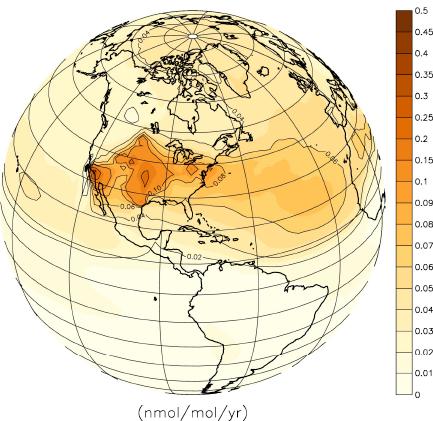

Modeled annual ozone increase: The rising ozone levels in summer are due to increased NMHC emissions over the USA.
Andrea Pozzer, MPI for Chemistry
A team led by scientists from the University of Colorado Boulder (CU)-Boulder, supported by Andrea Pozzer from the Max Planck Institute for Chemistry in Mainz, found that a steady decline of global ethane emissions following a peak in about 1970 ended between 2005 and 2010 in most of the Northern Hemisphere and has since reversed. Between 2009 and 2014, ethane emissions in the Northern Hemisphere increased by about 400,000 tons annually, the bulk of it from North American oil and gas activity. While methane is the main component of natural gas, it can contain up to 15 percent ethane.
The decline of ethane and other non-methane hydrocarbons (NMHC) starting around 1970 is believed to be primarily due to better emission controls, says lead study author Detlev Helmig, a fellow at CU-Boulder’s Institute of Arctic and Alpine Research (INSTAAR). The controls resulted in reduced emissions from oil and gas production, storage and distribution, as well as combustion exhaust from cars and trucks.
“About 60 percent of the drop we saw in ethane levels over the past 40 years has already been made up in the past five years,” said Helmig. “If this rate continues, we are on track to return to the maximum ethane levels we saw in the 1970s in only about three more years. We rarely see changes in atmospheric gases that quickly and dramatically.”
“These NMHC emission changes can potentially offset emission controls that have been implemented for curbing photochemical ozone production, and therefore can be a concern for attaining the ozone air quality standard”, says co-author Andrea Pozzer, group leader at the MPI for Chemistry. Although non-methane hydrocarbons (NMHCs) play a minor role as greenhouse gas they are crucial in the photochemical production of ozone (O3). The level of NMHC emissions is thus important for predicting changes in air quality. “We used a numerical model to assess the impact of such reversal trends in NMHC, showing that these could counteract all the effort made to reduce ozone pollution over the North Hemisphere in general and in the USA in particular”, says Andrea Pozzer. At the MPI for Chemistry he and his group develop and use numerical models to analyze and interpret observational data obtained from field campaigns and satellite remote sensing instruments.
Largest increases in ethane over areas of heavy oil and gas activity in the United States
Ethane, propane and a host of other NMHCs are released naturally by the seepage of fossil carbon deposits, volcanic activity and wildfires. But human activities now make up roughly three-quarters of the atmospheric ethane that is being emitted.
The air samples for the study were collected from more than 40 sites around the world, from Colorado and Greenland to Germany, Switzerland, New Zealand and the Earth’s Polar Regions. More than 30,000 air flasks were sampled at the National Oceanic and Atmospheric Administration’s (NOAA) Earth Systems Research Laboratory in Boulder over the past decade.
The study also showed that among the air sampling locations around the world, the largest increases in ethane and shorter-lived propane were seen over the central and eastern United States, areas of heavy oil and gas activity, said Helmig. “We concluded that added emissions from U.S. oil and gas drilling have been the primary source for the atmospheric ethane trend reversal,” he said.
The study also indicated that emissions of total NMHC in the Northern Hemisphere are now increasing by roughly 1.2 million tons annually.
The findings from the flask network, which INSTAAR and NOAA have been operating for more than 10 years, were supported by additional measurements showing very similar ethane behavior from a number of continuous global monitoring sites.
A component of natural gas, ethane plays an important role in Earth’s atmosphere. As it breaks down near Earth’s surface it can create ground-based ozone pollution, a health and environmental risk, especially in the summer months. “Ethane is the second most significant hydrocarbon emitted from oil and gas after methane,” Helmig said. “Other studies show on average there is about 10 times as much methane being emitted by the oil and gas industry as ethane.”
There is high interest by scientists in methane since it is a strong greenhouse gas, said Helmig. The new findings on ethane increases indicate there should be more research on associated methane emissions.
Original publication:
“Reversal of Global Atmospheric Ethane and Propane Trends largely due to US Oil and Natural Gas Production”: Detlev Helmig, Samuel Rossabi, Jacques Hueber, Pieter Tans, Stephen A. Montzka, Ken Masarie, Kirk Thoning, Christian-Plass Duelmer, Anja Claude, Lucy J. Carpenter, Alastair C. Lewis, Shalini Punjabi, Stefan Reimann, Martin K. Vollmer, Rainer Steinbrecher, James W. Hannigan, Louisa K. Emmons, Emmanuel Mahieu, Bruno Franco, Dan Smale, and Andrea Pozzer, Nature Geoscience, (2016), doi:10.1038/ngeo2721
(Press release of the University of Colorado Boulder with additions from MPIC)
Contact:
Mr. Andrea Pozzer, PhD
Max Planck Institute for Chemistry, Mainz
Atmospheric Chemistry Department
Phone: +49 (0)6131-305-4600
Email: andrea.pozzer@mpic.de
http://www.mpic.de/en/news/press-information/news/on-the-rise-ethane-concentrati…












